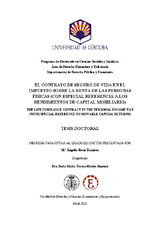El contrato de seguro de vida en el Impuesto sobre la Renta de las Personas Físicas (con especial referencia a los rendimientos de capital mobiliario)
The life insurance contract in the Personal Income Tax (with special reference to movable capital returns)
Autor
Recio Ramírez, M. Ángeles
Director/es
Mories Jiménez, Mª TeresaEditor
Universidad de Córdoba, UCOPressFecha
2020Materia
Contrato de seguroSeguros de vida
Régimen tributario
Impuesto sobre la Renta de las Personas Físicas
Rendimientos del capital mobiliario
Insurtech
Actividad mediadora
Derecho fiscal
METS:
Mostrar el registro METSPREMIS:
Mostrar el registro PREMISMetadatos
Mostrar el registro completo del ítemResumen
El presente trabajo de investigación versa sobre la tributación del contrato de seguro de vida en el Impuesto sobre la Renta de las Personas Físicas. La finalidad del mismo es analizar la tributación de esta figura contractual desde una visión integral, acometiendo el estudio desde la perspectiva impositiva que recae en la parte contraria a la compañía aseguradora, es decir, tomador, asegurado y beneficiario dentro del Impuesto sobre la Renta de las Personas Físicas; teniendo muy presente que se trata de un instrumento de ahorro a largo plazo, lo que explica el establecimiento de un alambicado régimen transitorio. Se analizan las diferentes rentas que pueden ser generadas por la figura contractual del seguro de vida, incluyendo los rendimientos de trabajo personal y los rendimientos de capital mobiliario. Así como las figuras más relevantes dentro del abanico de tipologías singulares del citado contrato: Planes de Previsión Asegurada, Contratos de Seguro de Vida Colectivos, Seguros de Dependencia, Planes Individuales de Ahorro Sistemático, Planes de Ahorro a Largo Plazo, Unit Linked y Seguros de Vida de Amortización de Préstamos Hipotecarios. Se examinan cada una de las situaciones que pueden suponer una particularidad dentro de la tributación del contrato de seguro de vida, así como la interpretación de la norma que aportan la jurisprudencia y la doctrina administrativa, cuyos vaivenes en algunos casos, proyectan más confusión que aclaración, provocando un menoscabo del principio de seguridad jurídica que termina afectando a la confianza legitima de los contribuyentes. Se ha intentado aportar luz a los aspectos más polémicos y también a los más disruptivos y, al mismo tiempo, hacer reflexionar al lector de forma provechosa. This research paper deals with the taxation of the life insurance contract in the Income Tax for Individuals. The purpose of this is to analyze the taxation of this contractual figure from an integral vision, undertaking the study from the tax perspective that falls on the opposite side to the insurance company, that is, policyholder, insured and beneficiary within the Income Tax of Physical Persons; Bearing in mind that it is a long-term savings instrument, which explains the establishment of a wired transitional regime. The different incomes that can be generated by the contractual figure of life insurance are analyzed, including personal work income, movable capital yields. As well as the most relevant figures within the range of singular typologies of the aforementioned contract: Insurance Plans, Collective Life Insurance Contracts, Dependency Insurance, Individual Systematic Savings Plans, Long Term Savings Plans, Unit Linked and Insurance Mortgage Loan Amortization Life. Each of the situations that can be considered as part of the taxation of the life insurance contract is examined, as well as the interpretation of the norm provided by jurisprudence, administrative doctrine, whose fluctuations in some cases, project more confusion than clarification, causing a prejudice to the principle of legal certainty that ends up affecting the legitimate trust of taxpayers. Attempts have been made to bring light to the most controversial and also to the most disruptive aspects and, at the same time, to make the reader reflect profitably.

